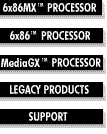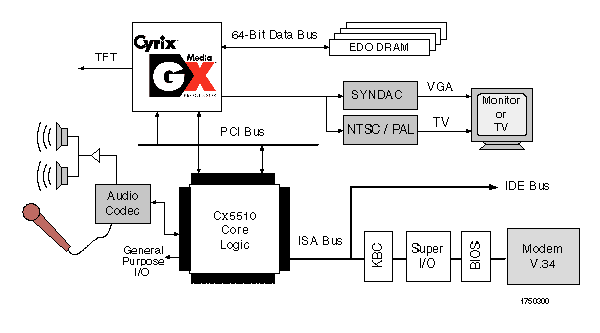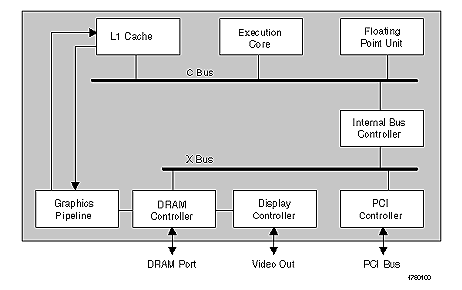

|
MediaGX™ Processor Architectural System Overview
The Cyrix MediaGX System establishes a new class of low-cost, high-performance
desktop and notebook PC computers. This system eliminates the traditional
audio and video cards, and all AT motherboard components of a PC.
The MediaGX System consists of two chips--the MediaGX
processor and the MediaGX Cx5510 companion chip.
The audio and graphics functions of the two chips operate
under the control of the Virtual System Architecture™ (VSA) design.
This design eliminates system conflicts and end-user configuration problems.
The MediaGX processor is a 64-bit data bus, x86-compatible
processor with a proven core. The CPU directly interfaces to a PCI bus
and DRAM memory. High quality SVGA is provided by an advanced graphics
accelerator on the MediaGX processor. The graphics frame buffer is stored
in main memory without the performance degradation associated with traditional
Unified Memory Architecture (UMA) system designs due to Cyrix's new Display
Compression Technology (DCT).
The companion chip, the MediaGX Cx5510, represents
a new generation of integrated, single-chip controllers for Cyrix's line
of MediaGX-compatible 64-bit processors. The Cx5510 bridges the MediaGX
processor over the PCI bus to the ISA bus, performs traditional chip-set
functions, and supports a sound interface compatible with industry-standard sound cards.
MediaGX Processor Feature Summary
MediaGX™ Processor Overview
MediaGX Processor The MediaGX processor not only executes x86 instructions using a proven Cyrix CPU core, it also acts as a virtual video card. This chip provides a high-quality video port that connects directly to a flat panel or to an external RAMDAC chip for CRT display. The processor also provides a 64-bit wide DRAM interface and video compression which allows video and main memory sharing without memory performance degradation. The MediaGX processor core operates from a 3.3 or 3.6 volt power supply, resulting in low power consumption at all clock frequencies. Where additional power savings are required (especially in portable applications), designers can make use of suspend mode, stop clock capability, and System Management Mode (SMM). Other features include:
The MediaGX processor is made up of eight major functional blocks, as shown below:
In general, data and code from DRAM or the PCI port travels over the X and C internal bus lines to the L1 cache where it is stored. Code instructions are fetched from the DRAM port or L1 cache by the execution core and floating point unit for processing. Video data is processed by the graphics pipeline and video display controller. Output from the video display controller is sent to a CRT monitor (via a RAMDAC chip) or directly to a flat-panel monitor. The PCI bus controller is used to control the PCI bus--there is no external CPU bus. The MediaGX Cx5510 performs functions such as interfacing to the IDE and I/O ports and the ISA bus.
Execution Core and Load/Store Unit There are six pipeline stages:
Write-Back allows data to be written to the cache and not immediately to main memory.
Branch Target Buffer
Floating Point Unit
Unified Write-Back Cache
Internal Bus Controller
PCI Controller
Graphics Pipeline
Display Controller The display controller retrieves image data from the frame buffer, inserts cursor and icon overlays into the pixel stream, generates display timing, and formats the pixel data for output to a variety of display devices. Virtual System Architecture™ (VSA) Technology A unique combination of hardware and software in the MediaGX provides compatibility with VGA and VESA graphic standards. The graphics pipeline and display controller are hardware assisted to support many VGA and VESA data operations, but all the of the VGA registers and controls are virtualized through Cyrix's Virtual System Architecture (VSA) software. VSA technology allows hardware to be replaced by software without sacrificing compatibility. Hardware to be virtualized is replaced with simple memory and I/O trapping hardware. When an application or non-Windows operating system attempts to access a VGA register or memory range, the MediaGX processor detects the access attempt and internally takes a System Management Interrupt (SMI) and enters into a highly-optimized System Management Mode (SMM). When the MediaGX goes into SMM, it saves the processor state and invokes a VSA handler that determines the cause of the SMI. The VSA handler then calls a VSA graphics driver to process the graphics access. The handler and VSA driver run in a special enhanced SMM mode making operations completely transparent to the application and operating system. While VSA technology provides full compatibility for all VGA and VESA modes and registers, the VSA graphic drivers take full advantage of the graphics pipeline boosting VGA performance in the MediaGX. The MediaGX also uses VSA software to provide industry-standard sound card compatibility.
MediaGX Cx5510 Feature Summary

MediaGX Cx5510 Overview The MediaGX Cx5510 represents a new generation of integrated, single-chip controllers for Cyrix's MediaGX line of x86-compatible 64-bit processors. The Cx5510 is a bridge to the ISA bus, performs traditional chip-set functions and supports a full-featured, compatible sound interface. The Cx5510 provides a PCI version 2.1 compatible interface operating up to 40 MHz. The Cx5510 contains a PCI to ISA bridge. For AT compatibility, the Cx5510 emulates two 8237 DMA controllers, an 8254 interval timer, and decode logic for AT register space. The Cx5510, in conjunction with the MediaGX processor and the VSA design, enables audio functions compatible with industry standards. The chip also provides a MIDI audio port and a two-channel (four-device) Bus Mastering IDE controller. Full-function power management allows for notebook as well as desktop designs.
PCI Bus Interface The Cx5510 contains configuration registers that are accessed through the PCI interface.
ISA Bus Interface
Power Management
Cyrix Corporation (Cyrix) reserves the right to make changes in the devices or specifications described herein without notice. Before design-in or order placement, customers are advised to verify that the information is current on which orders or design activities are based. Cyrix warrants its products to conform to current specifications in accordance with Cyrix' standard warranty. Testing is performed to the extent necessary as determined by Cyrix to support this warranty. Unless explicitly specified by customer order requirements, and agreed to in writing by Cyrix, not all device characteristics are necessarily tested. Cyrix assumes no liability, unless specifically agreed to in writing, for customers' product design or infringement of patents or copyrights of third parties arising from use of Cyrix devices. No license, either express or implied, to Cyrix patents, copyrights, or other intellectual property rights pertaining to any machine or combination of Cyrix devices is hereby granted. Cyrix products are not intended for use in any medical, life saving, or life sustaining system. Information in this document is subject to change without notice. Cyrix Corporation (Cyrix) has invested substantial resources in filing/acquiring patents from the U.S. Patent and Trademark Office and similar governing bodies worldwide covering the use of computer related products. Pending or issued patents may apply to processes, systems, methods, software and/or circuits referenced in this manual. Cyrix Corporation 94334-00 February 1997 (C) Cyrix Corporation. Cyrix is a registered trademark and MediaGX and Virtual System Architecture are trademarks of Cyrix Corporation. All other brand or product names are trademarks or registered trademarks of their respective holders.
|


